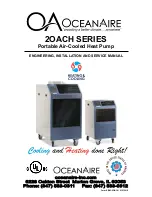
Installation Guide for NHPA Split-System Heat Pumps
10
High Voltage Power Supply
n
i
LIVE ELECTRICAL COMPONENTS!
During installation, testing, servicing
and troubleshooting of this product,
it may be necessary to work with live
electrical components. Failure to follow
all electrical safety precautions when
exposed to live electrical components
could result in death or serious injury.
!
WARNING
The high voltage power supply must agree with the
equipment nameplate.
OR
Make certain that the volts, hertz, and phase
correspond to that specified on the unit rating
plate, and that the service provided by the utility is
sufficient to handle the additional load imposed by
this equipment.
Power wiring must comply with national, state, and
local codes.
Follow instructions on unit wiring diagram located on
the inside of the access door, or cabinet and in the
wiring diagrams included with the unit.
ON
OFF
Disconnect
Switch
Thru-the-Wall
Heat Pump
Install a separate disconnect
switch at the location of the
through the wall unit.
Ground the unit per national,
state, and local code
requirements.
Start Up
1.
Ensure Sections 7 through 12 have been completed. Check
numbers once done.
2.
Turn on disconnect(s) to apply power to all equipment.
3.
Wait one (1) hour before starting the unit if compressor
crankcase heater accessory is used and the Outdoor Ambient is
below 70º
4.
Set system thermostat to ON.
Sequence of Operations
On a “call for cooling”, the thermostat “makes” circuits R-O,
R-G,and R-Y.Circuit R-G energizes the indoor blower motor relay.
Circuit R-O energizes the reversing valve. Circuit R-Y energizes
the contactor starting the compressor and outdoor fan.
When the thermostat is satisfied, the contacts open, de-
energizing the indoor blower relay, contactor, and reversing
valve. The indoor and outdoor fans and compressor will stop.
On a “call for heating”, the room heat pump thermostat “makes”
circuits R-G and R-Y. Circuit R-G energizes the indoor blower
motor relay. Circuit R-Y energizes the contactor starting the
compressor and outdoor fan. The reversing valve will not be
energized and the system will be in the heating mode. When
the room heat pump thermostat is satisfied, the contacts open,
de-energizing the indoor blower relay and contactor. The indoor
and outdoor fans and compressor will stop. When the indoor
thermostat is calling for heat (24VAC signal at the Y terminal),
the board begins monitoring the DFT terminal to determine if the
defrost sensor is calling for a defrost cycle. Once the board sees
a 24VAC signal at the defrost terminal, it recognizes that the coil
is cold enough to form ice and begins accumulating the 30, 50,
or 90 minute compressor run time (factory set at 50 minutes
adjusting of this may be necessary to provide complete defrost
for you climate zone). This time is only accumulated while the
compressor is running and the defrost sensor is closed. If the
selected time is reached and the defrost sensor is still calling
while the compressor is running, the control will enter a
defrost cycle. During a defrost cycle, the board will shut down
the condenser fan by opening the OF1 and OF2 terminals and
energize the reversing valve via the O terminal to enter a hot
gas defrost. It will stay in the defrost cycle for a maximum of 10
minutes, but will exit the defrost cycle if the defrost thermostat
is satisfied anytime before that 10 minutes expires. Upon exiting
the defrost cycle, the board will turn off the reversing valve
and close the OF1 and OF2 contacts to allow the fan to resume
operation.
If the outdoor temperature is cold enough to produce icing on
the outdoor coil during the heating mode (approximately 34°),
the condensate heater will be energized through the heater
thermostat located in the control box. This heater stays energized
during cold weather to keep any defrosted water from refreezing










































